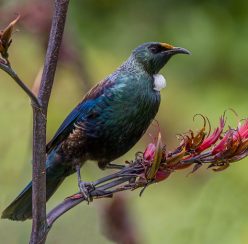North Island Saddleback

The North Island saddleback belongs to NZ’s unique wattlebird family, which includes the endangered North Island kokako, the extinct huia, and the likely extinct South Island kokako.. The decline of the saddleback began back in the mid-19th century when their forest habitat began to be cleared, and they were predated on by introduced ship rats, feral cats, and mustelids. Their steady decline meant that they were near extinction in the 20th century. The North Island saddleback was brought back from the brink by exhaustive work by DOC, and they now live on 19 islands, and their outlook for survival is very favourable.
Their vulnerability is due to the fact that they are often found hanging about at ground level. They are poor fliers, capable of clumsily negotiating short distances, but more often seen leaping from branch to branch. They are also bold and noisy, staking out territory fearlessly with displays of antagonism, dawn singing, and mildly threatening behaviour, such as grappling with the wattles of their foes, much like a 2am drunk.
Handsome birds, up to 25cm long, glossy black with a saddle of chestnut, and red wattles that dilate when in show-off display mode, they have all the panache of a smart-casual two-tone shoe, with a sharp toe and a medium heel! Their charming boldness and temerity enchanted early European bird fanciers as they are quite visible birds, and seemingly tame.
Maori legend says they got their bright saddle from Maui, who exhausted from his epic battle with the Sun asked the tieke to bring him a drink of water. The saddleback refused, so Maui swiped his still burning hand over his back as punishment, which gave him a blaze of bright plumage.
They nest near to the ground, in holes of tree trunks, in the crowns of ferns, or in epiphytes. Their fledglings can be spotted hopping about on the ground, building up wing strength. I wonder if humans had never arrived in NZ saddlebacks would be near flightless? I don’t know, but I do know that if the community continues to commit to not replacing our cats as they come to the end of their natural lives, tieke are a viable addition to our island population. We have sufficient habitat, and food for the predominantly insectivorous tieke to thrive.

